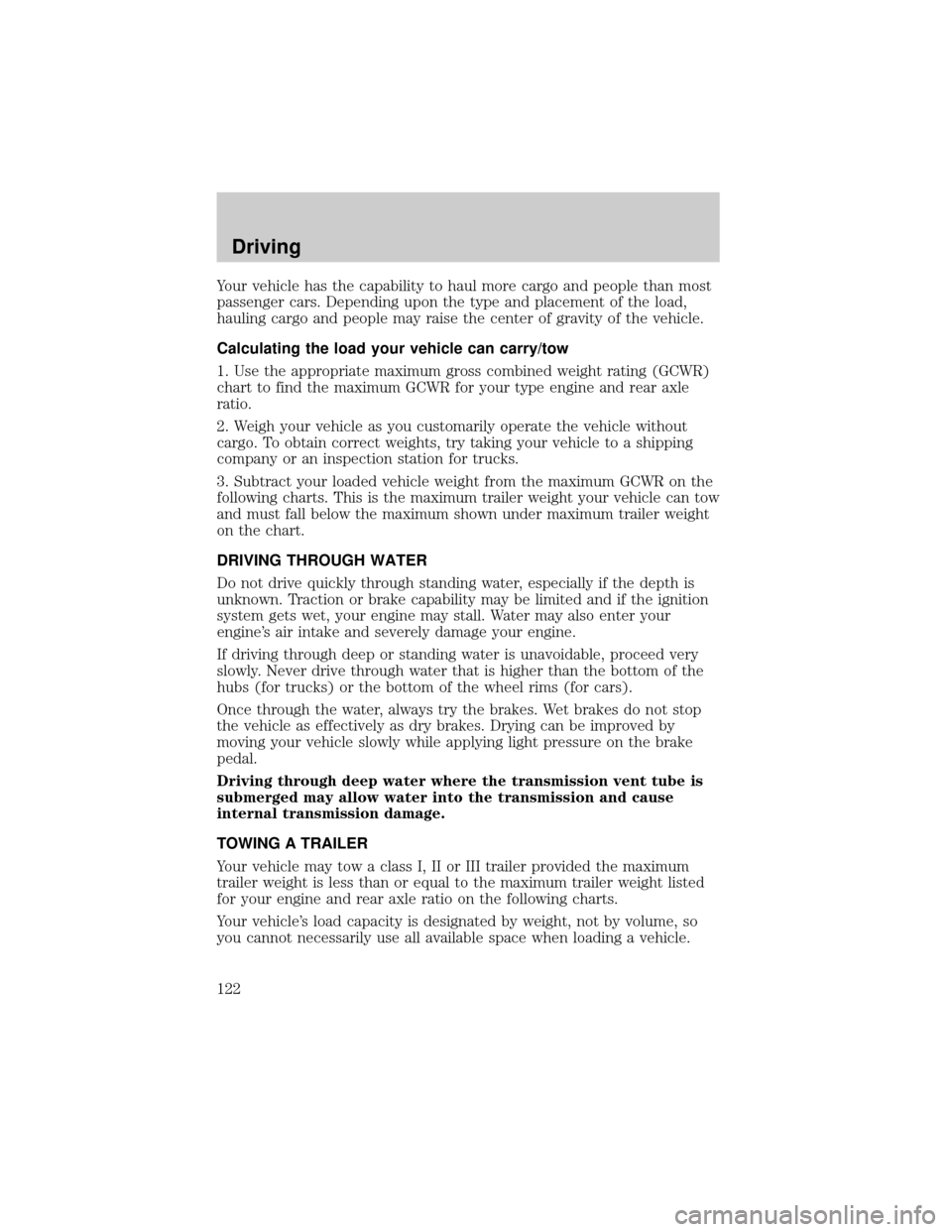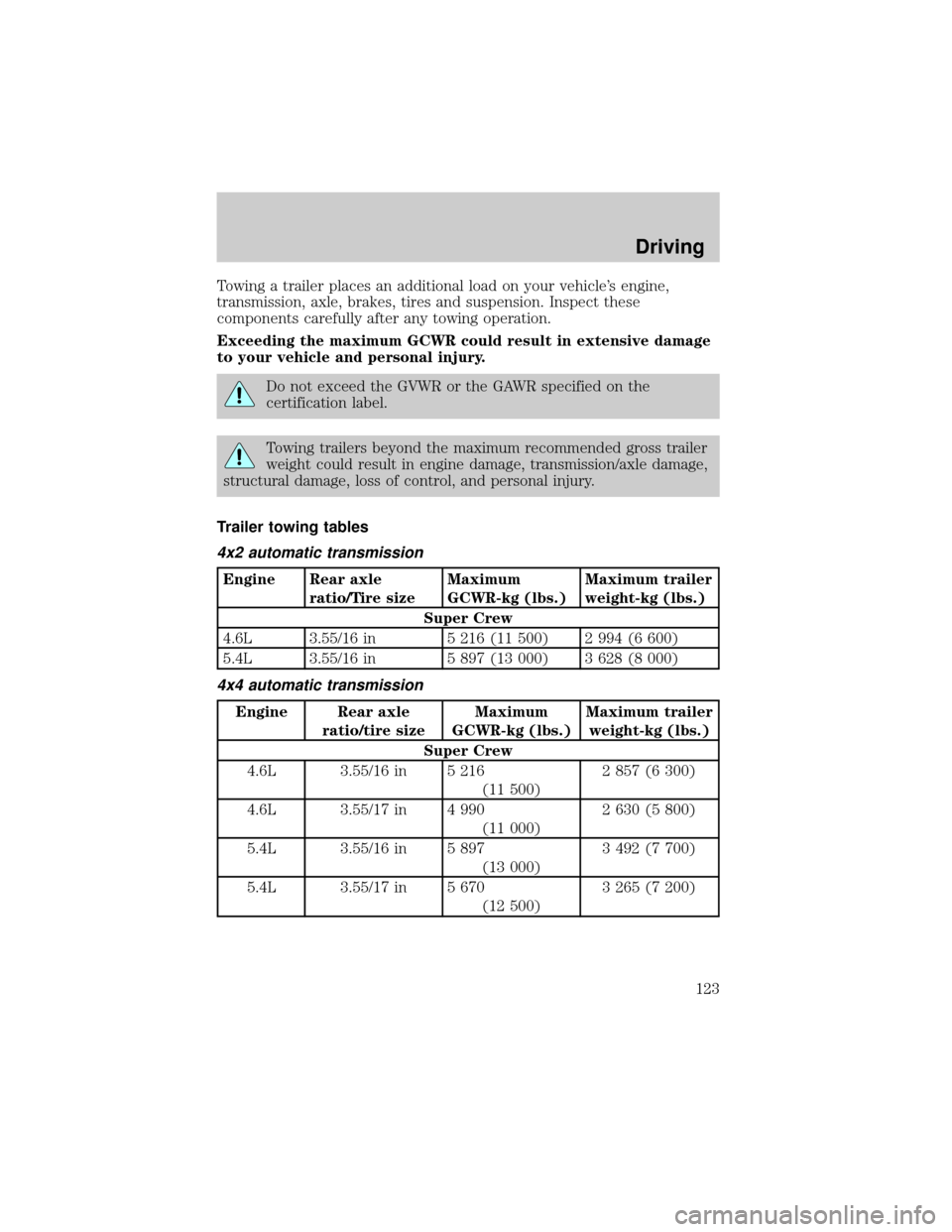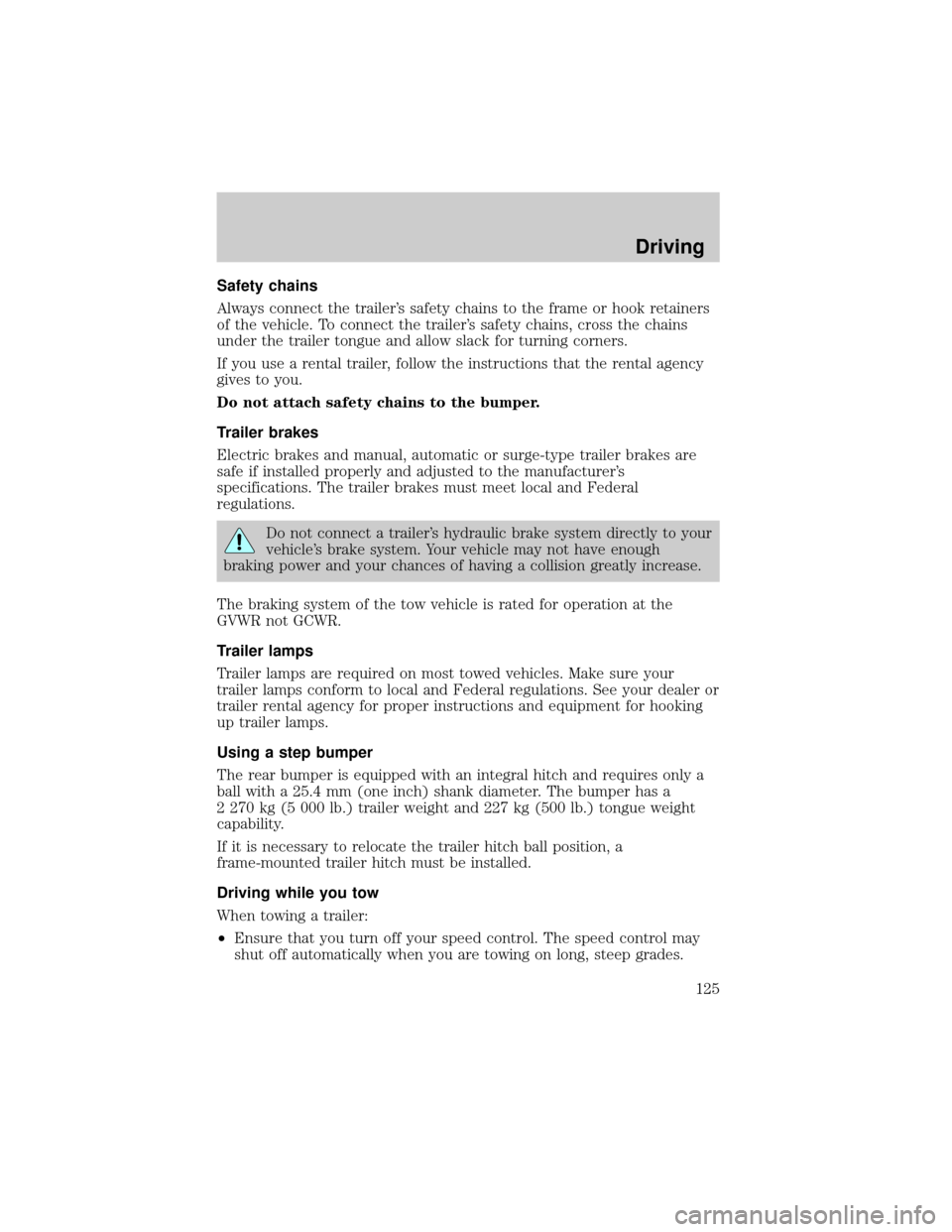2001 FORD F150 brakes
[x] Cancel search: brakesPage 119 of 224

Water intrusion into the transmission may damage the
transmission.
Replace rear axle lubricant any time the axle has been submerged in
water. The rear axle does not normally require a lubricant change for the
life of the vehicle. Rear axle lubricant quantities are not to be checked or
changed unless a leak is suspected or repair is required.
Driving on hilly or sloping terrain
When driving on a hill, avoid driving crosswise or turning on steep
slopes. You could lose traction and slip sideways. Drive straight up,
straight down or avoid the hill completely. Know the conditions on the
other side of a hill before driving over the crest.
When climbing a steep hill, start in a lower gear rather than downshifting
to a lower gear from a higher gear once the ascent has started. This
reduces strain on the engine and the possibility of stalling.
When descending a steep hill, avoid sudden braking. Shift to a lower gear
when added engine braking is desired.
When speed control is on and you are driving uphill, your vehicle speed
may drop considerably, especially if you are carrying a heavy load.
If vehicle speed drops more than 16 km/h (10 mph), the speed control
will cancel automatically. Resume speed with accelerator pedal.
If speed control cancels after climbing the hill, reset speed by pressing
and holding the SET ACCEL button (to resume speeds over 50 km/h [30
mph]).
Automatic transmissions may shift frequently while driving up steep
grades. Eliminate frequent shifting by shifting out of
(Overdrive) into
a lower gear.
Driving on snow and ice
A 4WD vehicle has advantages over 2WD vehicles in snow and ice but
can skid like any other vehicle.
Avoid sudden applications of power and quick changes of direction on
snow and ice. Apply the accelerator slowly and steadily when starting
from a full stop.
When braking, apply the brakes as you normally would. In order to allow
the anti-lock brake system (ABS) to operate properly, keep steady
pressure on the brake pedal.
Driving
119
Page 122 of 224

Your vehicle has the capability to haul more cargo and people than most
passenger cars. Depending upon the type and placement of the load,
hauling cargo and people may raise the center of gravity of the vehicle.
Calculating the load your vehicle can carry/tow
1. Use the appropriate maximum gross combined weight rating (GCWR)
chart to find the maximum GCWR for your type engine and rear axle
ratio.
2. Weigh your vehicle as you customarily operate the vehicle without
cargo. To obtain correct weights, try taking your vehicle to a shipping
company or an inspection station for trucks.
3. Subtract your loaded vehicle weight from the maximum GCWR on the
following charts. This is the maximum trailer weight your vehicle can tow
and must fall below the maximum shown under maximum trailer weight
on the chart.
DRIVING THROUGH WATER
Do not drive quickly through standing water, especially if the depth is
unknown. Traction or brake capability may be limited and if the ignition
system gets wet, your engine may stall. Water may also enter your
engine's air intake and severely damage your engine.
If driving through deep or standing water is unavoidable, proceed very
slowly. Never drive through water that is higher than the bottom of the
hubs (for trucks) or the bottom of the wheel rims (for cars).
Once through the water, always try the brakes. Wet brakes do not stop
the vehicle as effectively as dry brakes. Drying can be improved by
moving your vehicle slowly while applying light pressure on the brake
pedal.
Driving through deep water where the transmission vent tube is
submerged may allow water into the transmission and cause
internal transmission damage.
TOWING A TRAILER
Your vehicle may tow a class I, II or III trailer provided the maximum
trailer weight is less than or equal to the maximum trailer weight listed
for your engine and rear axle ratio on the following charts.
Your vehicle's load capacity is designated by weight, not by volume, so
you cannot necessarily use all available space when loading a vehicle.
Driving
122
Page 123 of 224

Towing a trailer places an additional load on your vehicle's engine,
transmission, axle, brakes, tires and suspension. Inspect these
components carefully after any towing operation.
Exceeding the maximum GCWR could result in extensive damage
to your vehicle and personal injury.
Do not exceed the GVWR or the GAWR specified on the
certification label.
Towing trailers beyond the maximum recommended gross trailer
weight could result in engine damage, transmission/axle damage,
structural damage, loss of control, and personal injury.
Trailer towing tables
4x2 automatic transmission
Engine Rear axle
ratio/Tire sizeMaximum
GCWR-kg (lbs.)Maximum trailer
weight-kg (lbs.)
Super Crew
4.6L 3.55/16 in 5 216 (11 500) 2 994 (6 600)
5.4L 3.55/16 in 5 897 (13 000) 3 628 (8 000)
4x4 automatic transmission
Engine Rear axle
ratio/tire sizeMaximum
GCWR-kg (lbs.)Maximum trailer
weight-kg (lbs.)
Super Crew
4.6L 3.55/16 in 5 216
(11 500)2 857 (6 300)
4.6L 3.55/17 in 4 990
(11 000)2 630 (5 800)
5.4L 3.55/16 in 5 897
(13 000)3 492 (7 700)
5.4L 3.55/17 in 5 670
(12 500)3 265 (7 200)
Driving
123
Page 125 of 224

Safety chains
Always connect the trailer's safety chains to the frame or hook retainers
of the vehicle. To connect the trailer's safety chains, cross the chains
under the trailer tongue and allow slack for turning corners.
If you use a rental trailer, follow the instructions that the rental agency
gives to you.
Do not attach safety chains to the bumper.
Trailer brakes
Electric brakes and manual, automatic or surge-type trailer brakes are
safe if installed properly and adjusted to the manufacturer's
specifications. The trailer brakes must meet local and Federal
regulations.
Do not connect a trailer's hydraulic brake system directly to your
vehicle's brake system. Your vehicle may not have enough
braking power and your chances of having a collision greatly increase.
The braking system of the tow vehicle is rated for operation at the
GVWR not GCWR.
Trailer lamps
Trailer lamps are required on most towed vehicles. Make sure your
trailer lamps conform to local and Federal regulations. See your dealer or
trailer rental agency for proper instructions and equipment for hooking
up trailer lamps.
Using a step bumper
The rear bumper is equipped with an integral hitch and requires only a
ball with a 25.4 mm (one inch) shank diameter. The bumper has a
2 270 kg (5 000 lb.) trailer weight and 227 kg (500 lb.) tongue weight
capability.
If it is necessary to relocate the trailer hitch ball position, a
frame-mounted trailer hitch must be installed.
Driving while you tow
When towing a trailer:
²Ensure that you turn off your speed control. The speed control may
shut off automatically when you are towing on long, steep grades.
Driving
125
Page 154 of 224

If you use a brake fluid that is not DOT 3, you will cause
permanent damage to your brakes.
Do not let the fluid level in the reservoir for the master cylinder
fall below the MIN mark. If master cylinder runs dry, this may
cause the brakes to fail.
WINDSHIELD WASHER FLUID
Checking and adding washer fluid
Check the washer fluid whenever
you stop for fuel. The reservoir is
highlighted with a
symbol.
If the level is low, add enough fluid
to fill the reservoir. In very cold
weather, do not fill the reservoir all
the way.
Only use a washer fluid that meets Ford specifications. Refer to
Lubricant specificationsin theCapacities and specificationschapter.
State or local regulations on volatile organic compounds may restrict the
use of methanol, a common windshield washer antifreeze additive.
Washer fluids containing non-methanol antifreeze agents should be used
only if they provide cold weather protection without damaging the
vehicle's paint finish, wiper blades or washer system.
Do not put washer fluid in the engine coolant reservoir. Washer
fluid placed in the cooling system may harm engine and cooling
system components.
ENGINE COOLANT
Checking engine coolant
Your engine's cooling system has been factory-filled with a 50/50 mixture
of distilled water and Ford Premium Engine Coolant E2FZ-19549-AA (in
Maintenance and care
154
Page 189 of 224

Washing your vehicle
Wash your vehicle regularly with
cold or lukewarm water. Never use
strong detergents or soap. If your
vehicle is particularly dirty, use a
quality car wash detergent. Always
use a clean sponge, washing glove
or similar device and plenty of water
for best results. To avoid spots,
avoid washing when the hood is still
warm, immediately after or during
exposure to strong sunlight.
During winter months, it is especially important to wash the vehicle on a
regular basis. Large quantities of dirt and road salt are difficult to
remove and also cause damage to the vehicle.
Any gasoline spilled on the vehicle or deposits such as bird droppings
should be washed and sponged off as soon as possible. Deposits not
removed promptly can cause damage to the vehicle's paintwork.
Remove any exterior accessories, such as antennas, before entering a car
wash. If you have wax applied to the vehicle at a commercial car wash, it
is recommended that you clean the wiper blades and windshield as
described inCleaning the wiper blades and windshield.
After washing, apply the brakes several times to dry them.
Underbody
Flush the complete underside of vehicle frequently. Keep body drain
holes unplugged. Inspect for road damage.
Maintenance and care
189
Page 216 of 224

Accessory delay ..........................59
Air bag supplemental
restraint system ..........................90
and child safety seats ..............92
description ................................90
disposal ......................................94
driver air bag ............................92
indicator light ........................9,94
operation ...................................92
passenger air bag .....................92
Air cleaner filter ................167,194
Air conditioning ..........................43
Ambulance packages ....................3
Antifreeze
(see Engine coolant) ................154
Anti-lock brake system
(see Brakes) .......................107,108
Anti-theft system
warning light .............................11
Armrests ......................................79
Audio system (see Radio) .........21
Automatic transmission
driving an automatic
overdrive .................................113
fluid, adding ............................161
fluid, checking ........................161
fluid, refill capacities ..............194
fluid, specification ..................199
Auxiliary power point .................20
Axle
lubricant specifications ...197,199
refill capacities ........................194
traction lok ..............................110
Battery .......................................165
acid, treating emergencies .....165
charging system
warning light .............................11
jumping a disabled battery ....142
maintenance-free ....................165
replacement, specifications ...194
servicing ..................................165
voltage gauge ............................15Bed extender ..............................62
Belt minder .................................86
Brakes ........................................107
anti-lock ............................107,108
anti-lock brake system
(ABS) warning light ..........10,108
brake warning light ..................10
fluid, checking and adding ....153
fluid, refill capacities ..............194
fluid, specifications ..........197,199
lubricant specifications ...197,199
parking ....................................109
pedals (see Power
adjustable foot pedals) ............19
shift interlock ..........................112
Break-in period .............................3
Capacities for refilling fluids ....194
Cassette tape player ...................29
CD changer .................................39
Certification Label ....................201
Child safety restraints ................95
child safety belts ......................95
Child safety seats ........................96
attaching with tether straps ..101
in front seat ..............................97
in rear seat .........................97,100
Cleaning your vehicle ...............188
engine compartment ..............191
exterior .............................189,190
exterior lamps .........................191
instrument panel ....................192
instrument panel lens ............192
interior .....................................192
plastic parts ............................191
safety belts ..............................193
washing ....................................189
waxing .....................................190
wheels ......................................190
wiper blades ............................192
Climate control (see Air
conditioning or Heating) ............43
Clock .......................................29,38
Index
216
Page 219 of 224

daytime running light ...............17
fog lamps ...................................18
headlamps .................................17
headlamps, flash to pass ..........17
instrument panel, dimming .....18
interior lamps ......................56,57
replacing
bulbs ............183,184,185,186,187
Lane change indicator
(see Turn signal) ........................46
Lights, warning and indicator ......8
air bag ..........................................9
anti-lock brakes (ABS) .....10,108
anti-theft ...................................11
brake ..........................................10
charging system ........................11
check coolant ............................11
cruise indicator .........................12
door ajar ....................................12
engine oil pressure ...................11
high beam .................................11
low fuel ........................................8
safety belt .................................10
service engine soon ....................8
speed control ............................50
turn signal indicator .................10
Load limits .................................120
GAWR ......................................120
GVWR ......................................120
trailer towing ..........................120
Loading instructions .................121
Locks
autolock .....................................70
childproof ..................................59
doors ..........................................59
Lubricant specifications ....197,199
Lumbar support, seats ...............76
Mirrors
fold away ...................................61
side view mirrors (power) .......60
Moon roof ....................................57
Motorcraft parts .................178,194Octane rating ............................176
Odometer .....................................15
Oil (see Engine oil) ..................150
Overdrive .....................................52
Panic alarm feature, remote
entry system ................................67
Parking brake ............................109
Parts (see Motorcraft parts) ....194
Pedals (see Power adjustable
foot pedals) .................................19
Power adjustable foot pedals .....19
Power distribution box
(see Fuses) ...............................134
Power door locks ...................59,70
Power steering ..........................110
fluid, checking and adding ....160
fluid, refill capacity ................194
fluid, specifications ..........197,199
Preparing to
drive your vehicle .....................111
Radio ............................................21
Relays ........................................130
Remote entry system ............66,67
illuminated entry ......................71
locking/unlocking doors ...........67
panic alarm ...............................67
replacement/additional
transmitters ..........................69,70
replacing the batteries .............68
Safety belts (see Safety
restraints) ...........13,79,80,81,82,83
Safety defects, reporting ..........215
Safety restraints ......79,80,81,82,83
belt minder ...............................86
cleaning the safety belts ...89,193
extension assembly ..................85
for adults .........................80,81,82
for children ..........................94,95
lap belt ......................................84
warning light
and chime ...................10,12,13,85
Safety seats for children ............96
Index
219